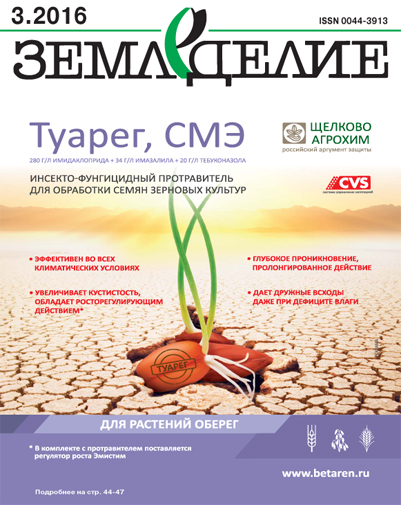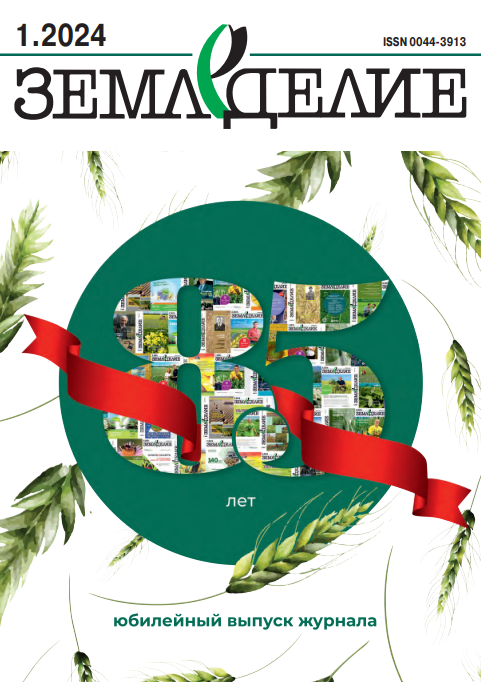Влияние технологии No-till на содержание питательных элементов в черноземе выщелоченном лесостепи Западной Сибири
Земледелие, 2016, № 3
УДК 631.51.01: 631.423.3
А.Н. ВЛАСЕНКО, академик РАН, директор
Н.Г. ВЛАСЕНКО, член-корреспондент РАН, зав. научно-исследо вательским Адрес электронной почты защищен от спам-ботов. Для просмотра адреса в вашем браузере должен быть включен Javascript.
Сибирский НИИ земледелия и химизации сельского хозяйства, п. Краснообск, Новосибирская обл., 630501, Российская Федерация
В условиях лесостепи Западной Сибири в длительном стационарном опыте проведено сравнение количества нитратного азота, фосфора и калия в черноземе выщелоченном среднесуглинистом при выращивании яровой пшеницы по No-till и технологии, основанной на глубоком рыхлении. Cодержание нитратного азота в метровом слое почвы перед посевом яровой пшеницы при выращивании культуры по No-till в среднем по опыту в контроле составляло 54,60±5,90 кг/га, в варианте с комплексным внесением агрохимикатов – 64,94±12,56 кг/га, по традиционной – 48,93±10,75 и 60,96±16,71 кг/ га соответственно. Отмечена устойчивая тенденция улучшения обеспеченности этим питательным элементом при выращивании яровой пшеницы по No-till технологии, в сравнении с традиционной: на фоне естественного плодородия почвы на 11,6%, в вариантах с комплексным применением удобрений и средств защиты растений – на 6,5%. При этом в севообороте с горчицей содержание нитратного азота было больше, чем в севообороте с овсом: при технологии, основанной на глубоком рыхлении, на 24,8%, в варианте с No-till – на 11,6%. Обе технологии создают сходные условия фосфорного и калийного питания растений. Содержание легкодоступного фосфора (по Карпинскому, Замятиной) в слое 0-40 см при обычной технологии в среднем по опыту составило 0,48 мг/кг почвы, при технологии No-till – 0,45 мг/кг. В большей степени величина этого показателя изменялась при внесении средств химизации: в контроле – 0,40 мг/кг почвы, в варианте с применением удобрений и средств защиты растений – 0,50 мг/кг почвы. Выявлена тенденция к снижению подвижных форм калия в слое почвы 0-40 см с течением времени, в среднем по опыту в варианте с обработкой почвы – 91,2 мг/кг, No-till – 84,8 мг/кг почвы.
Ключевые слова: технология, No-till, безотвальное рыхление, яровая пшеница, чернозем выщелоченный, нитратный азот, фосфор, калий.
Для цитирования: Власенко А.Н., Власенко Н.Г. Влияние технологии No-till на содержание питательных элементов в черноземе выщелоченном лесостепи Западной Сибири // Земледелие. 2016. №3. С. 17-19.
Influence of No-till Technology on the Content of Nutrients in Leached Chernozem of Forest-Steppe of the Western Siberia
A.N. Vlasenko, N.G. Vlasenko
Siberian Researches Institute of Soil Management and Chemicalization of Agriculture, Krasnoobsk, Novosibirskaya obl., 630501, Russian Federation
Under conditions of forest-steppe of the Western Siberia in the long-term stationary experiment the comparison of amount of nitrate nitrogen, phosphorus and potassium in the leached middle-loamy chernozem at cultivation of spring wheat according to no-till and technology based on deep loosening was carried out. The studies revealed no significant differences in the content of nitrate nitrogen in a meter layer of soil before sowing of spring wheat: on the average in the test at cultivation of wheat by no-till technology in the control it was 54.60 ± 5.90 kg/ha, in the variant with complex using of agrochemicals – 64.94 ± 12.56 kg/ha; for the traditional technology it was 48.93 ± 10.75 and 60.96 ± 16.71 kg/ ha respectively. However, it was noted a steady trend of improving of nitrate nitrogen provision at cultivation of spring wheat according to no-till technology in comparison with the traditional one: against the background of natural soil fertility – by 11.6%, in variants with integrated use of fertilizers and plant protection means – by 6.5%. At the same time the content of nitrate nitrogen in a crop rotation with mustard was more by 24.8% at the technology, based on deep loosening, and by 11.6% – in the no-till technology, than in a crop rotation with oats. Both technologies create similar conditions of phosphorus and potassium nutrition of plants. The content of readily available phosphorus (by Karpinsky, Zamyatina) in a layer of 0-40 cm on the average was 0.48 mg/kg of the soil at the usual technology and 0.45 mg/kg – at no-till technology. To a large extent this indicator changed at application of chemization means: in the control it was 0.40 mg/kg of the soil, in the variant with fertilizers and plant protection means it was 0.50 mg/kg of the soil. It was revealed the tendency to decrease in the content of mobile forms of potassium in a layer of 0-40 cm of the soil in the course of time; on the average in the test in the variant with soil treatment it was 91.2 mg/kg, for no-till – 84.8 mg/kg of the soil.
Keywords: technology, no-till, nonmoldboard loosening, spring wheat, leached chernozem, nitrate nitrogen, phosphorus, potassium.
Author Details: A.N. Vlasenko, member of the RAS, director; N.G. Vlasenko, corresponding member of the RAS, head of research center (e-mail: Адрес электронной почты защищен от спам-ботов. Для просмотра адреса в вашем браузере должен быть включен Javascript.)
For citation: Vlasenko A.N., Vlasenko N.G. Influence of No-till Technology on the Content of Nutrients in Leached Chernozem of Forest- Steppe of the Western Siberia. Zemledelie. 2016. No 3. Pp. 17-19 (In Russ.).










